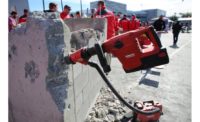 |
Transportation Senior Editor Aileen Cho recently picked the brain of Michael Della Rocca, president and regional managing director in North America, for Halcrow Inc., which he joined in 2007. He directs all of Halcrow’s North American activities in maritime, transportation, consulting, water and power, infrastructure, buildings and environmental.
What are some of the major tri-state area projects you're working on right now?
We’re working on a 40-plus story office tower adjacent to the World Trade Center site. We’re also working with architect SOM for the Jets, doing their training facility in New Jersey. The Hudson River Park Trust has a 5-mile park traversing Manhattan. We’re lead waterfront designer for that. We also work for the Intrepid. When they brought it in, we inspected the piers. And, we’re working for Global Terminal and Containers in a design-build project with Weeks Marine to deepen the berth [at port facilities owned by the Port Authority of New York and New Jersey].
Any thoughts on the New Jersey transportation fund issue, and Governor Jon Corzine’s (D) hope of privatizing the turnpike?
Here there are lots of stakeholders with very different perspectives. Each has a very entrenched power base and an ability to influence public policy decisions. When you look at Governor Corzine trying to put a concession in place or at [New York Mayor] Bloomberg trying to implement congestion pricing -- these are very bold, creative, out-of-box approaches. These officials have stepped forward with creative solutions -- but it's difficult to gain consensus.
What do you see as the top-priority projects for NY/NJ? What are the challenges involved?
The highest priority are the World Trade Center site projects. East Side Access has gained momentum. Looking out a bit further, the Access to the Region’s Core project now jointly funded by New Jersey Transit and the Port Authority, that’s a top priority. Stewart Airport clearly is a top air travel priority. The Tappan Zee Bridge is important.
Tell me more about Nation's Port.
I’m on the board of this group. Nation’s Port formed a year and a half ago to speak to the need for better goods movement in the tri-state region. The group wants to be principally driven by the private sector and help facilitate investment strategy. This is the largest freight market in the U.S. and by far the most congested. It’s one that needs a 24/7 operating approach.
What has changed about the engineering industry since your days with Parsons Brinckerhoff, STV and Washington Group?
The first driver is globalization. There are companies 10 years ago that when they looked at diversifying they might say, "I’m a New York company; now I’ll open an office on the West Coast.". Those firms now say “I’ll open an office in Abu Dhabi." And it’s not just the megacompanies. You talk to firms with 100-200 people, and they’re just as interested in global opportunities.
You’ve also got clients who have told the industry, “We want world-class talent for our New York projects". Best practices from Europe or the Far East -- they’re interested in those. And lots of firms are increasing their presence in America, including Halcrow.
Eight years ago you might see 4 firms doing more than $1 billion worth of work. Now 14 firms like that are on ENR’s lists. There are many more firms funded partly with private equity than before. Investors who in prior climates might have looked at telecommunications, biotechnology or other investment opportunities are now looking at the engineering and construction industry.
What about public-private partnerships?
Ten years ago public-private partnerships was really an infant market. Now there are 23 states with enabling legislation for PPPs. Halcrow’s working in Virginia, Florida, New Jersey, and Texas with clients like Goldman Sachs or Macquarie, which are looking at U.S investment opportunities. That opportunity was nowhere near as prevalent 10 years ago.
How has the role of the engineer changed?
The way the engineering industry views itself on the value chain for delivering projects has changed. It used to be that engineers were the designers for the owner or architect. Now a lot are looking to become more involved in the risk of the project in exchange for greater participation in economic value. They take on project management oversight roles and are partnering with contractors. In some instances, they lead the design-build effort as opposed to the contractor. The engineer’s role is moving back to how it was in the 1800s — as a master builder.


Post a comment to this article
Report Abusive Comment